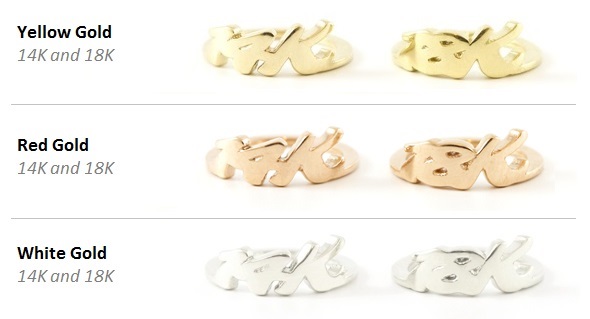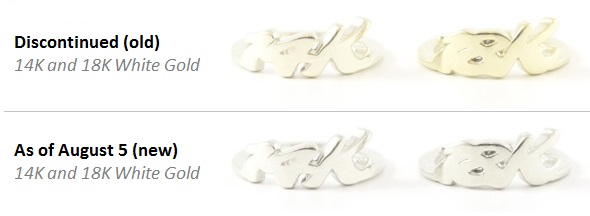
We Listened to Your Feedback and Updated our 14K and 18K White Gold
3D printing is making a huge impact on how goldsmiths work and design. Since we launched white gold, we received a lot of feedback from you. After analyzing your requests and testing new alloys, we are now happy to announce that we have updated 14K and 18K white gold.
When it comes to gold, i.materialise always was a forerunner. In February this year we announced the launch of 18K gold next to our existing 14K option. In June we reduced prices and managed to make production two days faster.
Moreover, we offer our customers the possibility to choose between three different color options: yellow, red and white gold. These color options are achieved by adding different alloys of metals to the gold. We listened to your feedback on these color options and we’re excited to tell you that we have changed the alloy of white gold: it will now appear whiter and will thus make the distinction between yellow and white gold easier (as you can see in the overview below).

Our three gold color options: yellow gold, red gold, and our updated white gold.
White Gold: A Relative Term
Why was this change necessary? Well, here’s the background story: the term ‘white gold’ is used very loosely in the jewelry industry to describe karat gold alloys with a whitish hue. The term ‘white gold’ covers a large spectrum of colors that borders or overlaps with pale yellow, tinted brown, and even very pale rose.
To create a white color effect, nickel is often added to the alloy. Since 1 out of 8 people have allergic reactions to nickel, and in order to comply with a European regulation called REACH, we didn’t want to go this way and preferred a slightly yellowish look.
The jewelry industry often conceals these off-white colors by using rhodium plating. It is a common misconception that the color of the rhodium plating, which is seen on many commercial pieces, is actually the color of white gold. In reality, however, rhodium plating will inevitably wear off. So you would need to ask your local jewelry shop to apply a rhodium plating to whiten your model each time it wears off.
Community Feedback: A New White Gold
Over the last months we received quite some feedback from you, our community, about our gold color options. While most of it was positive, we noticed that some customers were not satisfied with the color of white gold. This is why we tried to improve the alloy and create white gold items that would match our customers’ expectations even better.
Since neither nickel nor rhodium plating were acceptable options, we decided to add palladium, a rare and lustrous silvery-white metal, to the alloy. The result is a much whiter color as you can see in the picture below.
Our ‘old’ white gold color can be seen in the first line and features hints of a yellowish color. As of today, the updated white color (which you can see below) will replace this option.
On a more technical note, the exact chemical changes are as follows:
Discontinued (old):
- 14K white gold contained 58.5% gold, 34.04% silver, 4.15% copper, and 3.32% zinc.
- 18K white gold contained 75.2% gold, 21.6% silver, 1.2% copper, and 2% zinc.
As of August 5 (new):
- 14K white gold now contains 58.5% gold, 17.43% silver, 10.79% palladium, 9.13% copper, and 4.15% zinc.
- 18K white gold now contains 75.2% gold, 10.42% silver, 6.45% palladium, 5.46% copper, and 2% zinc.
You can find out more about our gold options on a dedicated material page. If you would like to give it a try yourself, why not join our current 3D printed jewelry challenge and submit your design? If you are searching alternatives for real gold, a look at our new gold-plated brass options might be interesting.
Recommended Articles
No related posts.



